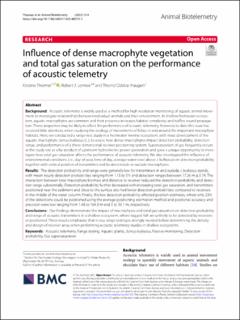| dc.description.abstract | Acoustic telemetry is widely used as a method for high resolution monitoring of aquatic animal movement to investigate relationships between individual animals and their environment. In shallow freshwater ecosystem, aquatic macrophytes are common and their presence increases habitat complexity and baffles sound propagation. These properties may be likely to affect the performance of acoustic telemetry, however, to date this issue has received little attention, when studying the ecology of movements of fishes in and around the important macrophyte habitats. Here, we conducted a range-test study in a freshwater riverine ecosystem, with mass development of the aquatic macrophyte Juncus bulbosus (L.), to assess how dense macrophytes impact detection probability, detection range, and performance of a three-dimensional receiver positioning system. Supersaturation of gas frequently occurs at the study site as a by-product of upstream hydroelectric power generation and gave a unique opportunity to investigate how total gas saturation affects the performance of acoustic telemetry. We also investigated the influence of environmental conditions (i.e., day-of-year, time of day, average water level above J. bulbosus) on detection probability together with vertical position of transmitters and location inside or outside macrophytes. The detection probability and range were generally low for transmitters in and outside J. bulbosus stands, with mean hourly detection probabilities ranging from 1.18 to 5% and detection ranges between 17.26 m ± 0.74. The interaction between total macrophyte biomass and distance to receiver reduced the detection probability and detection range substantially. Detection probability further decreased with increasing total gas saturation, and transmitters positioned near the sediment and close to the surface also had lower detection probabilities compared to receivers in the middle of the water column. Finally, the low detection probability affected position estimates, where only 23% of the detections could be positioned using the average positioning estimation method and positional accuracy and precision were low ranging from 1.48 to 164.8 m and 0 to 50.1 m, respectively. | en_US |

